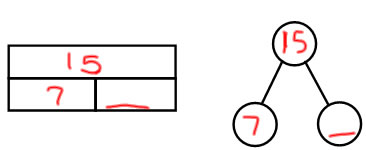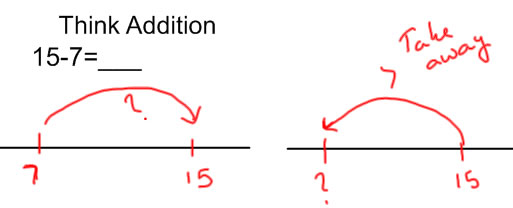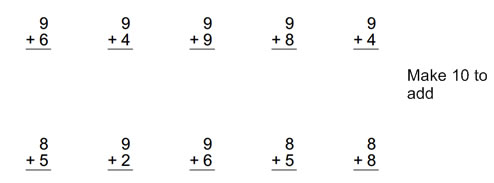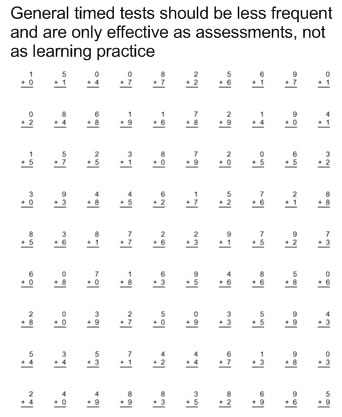
Think addition and fact families:
The best way to figure out subtraction facts is by using your addition knowledge. We can connect subtraction to addition by using part-whole ways of thinking of subtraction. So, the subtraction problem: 15-7=___ can be shown in a part-whole diagram by showing that 15 is the whole and 7 is a part. The missing number is the other part:

The part whole digram helps us see that we can find the difference by figuring out a missing number addition problem: 7+___=15.
One way we organize addition and subtraction problems is by fact families. In the fact family for the parts 7 and 8 and the whole 15, the equations are:
7+8=15
8+7=15
15-7=8
15-8=7
We can write a fact family with a missing number too. Just put a ___ in place of 8:
7+__=15
__+7=15
15-7=__
15-__=7
We also use number lines to show subtraction problems.
| We can show subtraction on a number line in a way that connects to addition: what is the difference or distance between the minuend or subtrahend. | We can show subtraction on a number line as take away--if we go back from the minuend number by the subtrahend number, where do we end up? |

If we bridge with 10 using the think-addition version, we would be using building up through ten to solve the problem, if we bridge through 10 using the take away version, we would be backing down through ten to solve the problem.
If we know the addition fact 7+8=15, we can solve the problem directly from the left number line: 7+8=15, so 15-7=8.
Thinking of subtraction in terms of a part-whole model helps children connect addition to subtraction and use addition facts to solve subtraction problems.
Using addition so solve subtraction problems is useful because:
Click here for an overview of which strategies are efficient for what facts in addition and subtraction.
Recommendations for drill on basic facts:
I highly recommend Rathmell's suggestions about drill for basic facts. Most of the people I hear talking about drill and practice and about timed tests fall into the extreme camps: yes, that's the only way to learn the basic facts, or no, you should never do that. Rathmell's suggestions seem to me to be between the extremes which is a position I can respect. Here are some key quotes with examples from the two essays you're assigned to read (What are some guidelines for drill? and: What are some teaching strategies that meet these guidelines for drill?)
"Do not use drill on a group of basic facts until after the children are able to use an efficient thinking strategy to solve those basic facts. Then the drill will increase the speed and accuracy of the use of that efficient thinking"
We want children to put the basic facts into their long term memory (hence the drill and practice), but isolated facts are easy to forget, so we want them to remember the facts in a connected framework with how to figure out the fact, and other facts that are similar, so it will be easier to access the fact later. We also want them to remember the fact and a good strategy, and not just memorize the process of counting.
"Organizing practice in clusters of basic facts, that can easily be solved with a given thinking strategy, enables children to have success with that cluster of facts as they practice using that thinking strategy"
When children practice a cluster of basic facts that can be solved by an efficient strategy then more of their thinking is devoted to that strategy and associating those facts with the strategy and with each other than if they are practicing randomly generated facts. It's a little harder to find, but you can make or find fact practice sheets that focus just on a single cluster of facts. For example, I made these make ten to add problems from http://www.math-aids.com/ by asking for problems where the first addend was 8 or 9.

"First, practice a few minutes each day or every other day. Second, introduce only a few new facts at a time. It has been shown to be very effective to introduce only about 10-15 new facts at a time and then provide about two weeks of practice with those before introducing other new facts. "
It's more effective to practice this sort of thing for a short time but do it often than to practice it for a long time only once. That's true of a lot of things.
It's more effective to practice and learn just a few (10-15) new facts at a time. If everything you are working on is equally new and unfamiliar, it will take much longer to learn than if you are learning just a few new things at a time.
This means that if you are doing timed tests as part of your math facts practice, it's more effective to do them in the way Rathmell suggests in the second essay: Provide problems that can be done within a single cluster of problems and a single strategy (count back to subtract in this case). Give children successively shorter time limits, where the first set can be finished by everyone (everyone has success), the second by some, and the third probably no one will finish. The time limits encourage speed and memorization, but everything is set up to make as many children successful (and see themselves as successful) as possible. |
 |
| Rathmell suggests that your assessment timed tests also include only problems that children have efficient strategies for (ones you are currently working on, and ones from earlier in the year). At least, if you are giving timed tests with all 100 facts on them, be aware that while these can be helpful assessments for you (to know what children need to work on next), they are not very helpful as practice for children to learn the facts (there are too many different facts and too many appropriate strategies to be able to focus and learn efficiently). |  |
In summary, Rathmell recommends that to teach basic facts, we